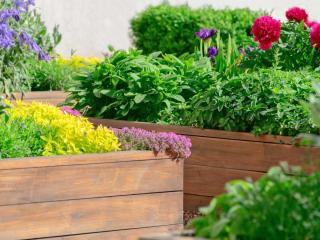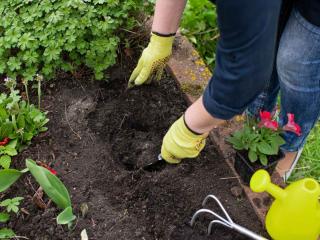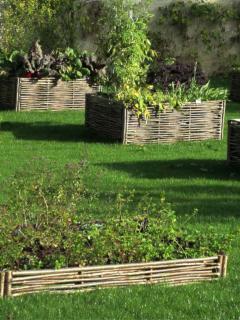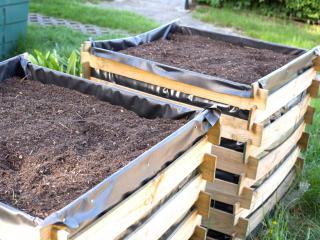There are many ways to work in the garden, but with a raised garden, everything becomes easy!
Raised garden quick facts
Name – raised garden
Similar to – standing garden
Initial setup – a bit intensive, DIY
Maintenance – easy & comfortable
Cost – minimal to expensive
A raised garden is especially useful for growing vegetables, organizing flower beds, and setting up herb patches. It’s a great way to garden without bending over, solving the common ailment of almost every gardener: back pain!
What is a raised garden?
A raised garden is a garden where the soil level is brought up in some places. The gardener can walk around it and can work the soil directly while standing up. Pathways and raised growing beds are clearly marked.
 Having a raised garden makes a lot of things better, and in the following lines you’ll discover:
Having a raised garden makes a lot of things better, and in the following lines you’ll discover:
- how healthy a raised garden is – for the gardener and for the plants!
- what the best height for a raised garden is
- the best plants to grow in a raised garden bed – and which ones to avoid
- different raised garden layouts or patterns you can create
- finally, easy steps on how to set the raised garden up!
Benefits of a raised garden
Essentially, a raised garden does away with all or most of the bending over, kneeling, crouching, getting down that usually comes with working the soil.
All your gardening is performed standing up. This eliminates back pain, but there’s much more to a raised garden than that.
Benefits of a raised garden for the gardener
 In short, ease of work and risk of injury are reduced.
In short, ease of work and risk of injury are reduced.
- Less back pain thanks to not bending over
- No risk of falling over or getting stuck
- No need to manipulate awkward tools like long-handled rakes and spades. Hand garden tools are all that’s needed.
- Better harvest, easier to harvest
- Close-up of plants increases awe and wonder and stimulates the senses
- Weeding and care can become part of a healthy morning stroll routine
Benefits of a raised garden for plants
 Plants also have advantages with raised gardening:
Plants also have advantages with raised gardening:
- No more treading on soil, no more soil compression
- Soil health is increased with better air circulation
- Better drainage, even with clay or heavy soil
- Moisture retention is increased
- More stable temperatures to the root system in summer (cooler air around and beds) and spring/fall (quicker rise in soil temperature on warm days)
- Pests are seen earlier and treated easier (hand-picking made easy, underside of leaves easy to reach)
- Spots of shade and nooks and crannies offer more shelter for beneficial animals
Best height for a raised garden
The perfect height of the garden depends on how you set it up, which plants you hope to grow… and how tall you are!
Here are a few ways to determine the ideal height for a raised garden.
Ankle-high raised garden
A line of hollow blocks or simple firewood logs marks the edges of the growing bed, which is filled with a mix of soil, compost and especially mulch.
- Is actually a generous implementation of the mulch garden, with borders or edges.
- Cheapest and easiest to set up, most flexible option, but still requires stooping and kneeling.
- Is great for testing a layout out for a year or two in real life since it can be redrawn easily.
- Solves all heavy soil and clay soil issues.
- Stays rather discreet.
- Perfect for pole vegetables like bean, snow pea, corn…
- Tall berry shrubs grow very well in low raised garden beds and are easy to harvest, such as raspberry, blackberry, red currant…
Knee-high raised garden
 Easy to find in horticulture stores, ready-made beds are simply rested on the ground and filled. No stakes or heavy securing needed.
Easy to find in horticulture stores, ready-made beds are simply rested on the ground and filled. No stakes or heavy securing needed.
- Perfect for almost every application.
- A plank drawn between two beds makes for a great seat.
- Ideal for deeper root vegetables like asparagus, potato.
- Nice visual effect for landscaping.
- Great for vegetables that require ridging and blanching like endive, leek, dandelion.
- Short berry shrubs grow well here, such as blueberry and bilberry
Waist-high raised garden
 Requires sturdy stakes and strong planks or masonry to avoid caving and collapsing walls. An alternative is any form of raised planter or table planter.
Requires sturdy stakes and strong planks or masonry to avoid caving and collapsing walls. An alternative is any form of raised planter or table planter.
- Most comfortable for everyday maintenance like weeding and watering.
- Great for shallow root vegetables like carrot, radish, beet, shallot and turnip.
- Perfect for a herb garden
- Ideal for leaf vegetables like lettuce, spinach, and edible flowers (including plants of the cabbage family like cauliflower, broccoli and mizuna cabbage).
- Ground-hugging berry shrubs like strawberry are perfect here.
- Ideal for any kind of therapy and health recovery activities.
- Allows even the oldest of the elderly to keep indulging into their favorite gardening pastimes.
Smart tip about raised garden height
It’s a good idea to have raised garden beds of different heights within the same garden, to best match plant needs and landscaping effect. Taller beds can be set in the back to create volume and embellish the scenery.
Even better, with bricks, hollow blocks, and stones, you can simply start low and keep raising the bed year after year, as you keep adding nutritious organic mulch.
Layout and pattern
For a raised garden, there are quite a few options to choose from.
Setting up a raised garden
Steps to set up a raised garden are the following:
- 1 – If you’re renting, check with the owner what you’re allowed to do. Usually, small beds and low, ankle-height beds are OK.
- 2 – Map out your raised garden, marking any trees. Note areas that are shaded and sunny. Identify the best spot for a compost, and check where the faucet or rainwater reservoir is for watering.
- 3 –
 Draw up your raised garden. Start off with a paper version, or go live and use orange or pink-colored yarn that you tie around sticks or poles in the ground.
Draw up your raised garden. Start off with a paper version, or go live and use orange or pink-colored yarn that you tie around sticks or poles in the ground.
- 4 – Determine which materials you’re going to use for your raised garden, purchased or recycled.
- 5 – Invite family, friends or neighbors to pitch in and get to work!
Read also:
Images: 123RF: Ivan Taborov, vejaa, CC BY 2.0: Maja Dumat, CC BY-SA 2.0: Crispin Semmens; own work: Rosalyn & Gaspard Lorthiois; Pixabay: Nathalie; shutterstock: Maria Sbytova


 Having a raised garden makes a lot of things better, and in the following lines you’ll discover:
Having a raised garden makes a lot of things better, and in the following lines you’ll discover: In short, ease of work and risk of injury are reduced.
In short, ease of work and risk of injury are reduced. Plants also have advantages with raised gardening:
Plants also have advantages with raised gardening: Easy to find in horticulture stores, ready-made beds are simply rested on the ground and filled. No stakes or heavy securing needed.
Easy to find in horticulture stores, ready-made beds are simply rested on the ground and filled. No stakes or heavy securing needed. Requires sturdy stakes and strong planks or masonry to avoid caving and collapsing walls. An alternative is any form of raised planter or table planter.
Requires sturdy stakes and strong planks or masonry to avoid caving and collapsing walls. An alternative is any form of raised planter or table planter. Draw up your raised garden. Start off with a paper version, or go live and use orange or pink-colored yarn that you tie around sticks or poles in the ground.
Draw up your raised garden. Start off with a paper version, or go live and use orange or pink-colored yarn that you tie around sticks or poles in the ground.